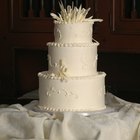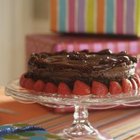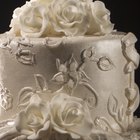
While refrigerating a cake after applying the crumb coat and before covering it with fondant can be helpful, it is not absolutely necessary. Following the traditional steps for preparing a cake allows you to go straight from assembly to final covering without the need to chill the cake. Many pastry chefs and home bakers prefer to chill the partially finished cake for a variety of reasons, including stability. Careful attention to your cake preparation should eliminate the need for refrigeration, but the decision is ultimately one of personal preference.
Set Up for Stability
The primary benefit to refrigerating your cake after the crumb coat, or dirty icing, is to allow the filling between the layers to set up fully. When you cover a cake in fondant, the weight of the topping can cause any layers that are not adequately stable to slide, making the cake appear tilted. The weight can also cause inner layers of frosting to bulge out, creating ridges between each layer that appear under the smooth fondant. The cold from refrigeration will help the filling solidify between the layers, making your cake better able to stand up to the weight of the fondant.
Risk of Refrigeration
If you refrigerate your cake after the crumb coat, leave it just long enough to set up the frosting. When a cake sits in the refrigerator, it tends to dry out, affecting the crumb and overall taste of the dessert. To allow the crumb coat and filling between the layers to set up, you will need to place the cake in the refrigerator uncovered, which heightens the risk for drying out. Remove the cake as soon as possible. Alternatively, if you must store the cake in the refrigerator for more than an hour or two, cover it tightly with a layer of plastic wrap followed by a layer of aluminum foil as soon as the frosting has set.
Beyond the Crumb Coat
Though fondant creates a smooth, clean look for a cake, the flavor can be off-putting to many people. Adding a full layer of frosting below the smooth topping offers a tasty layer even for those who set aside the fondant before eating. Allow the crumb-coated cake to set up, whether on the counter or in the refrigerator. Then spread a clean, even layer of your frosting of choice over the crumb coat. You may refrigerate again at this stage, if you choose, or apply the fondant directly to the frosting. The extra frosting can help the fondant adhere more easily, as well.
Trust the Process
If you are careful while assembling your cake and correctly follow your recipe, your cake will withstand the weight of the fondant, regardless of whether you choose to refrigerate. Use a sharp serrated knife to smooth off the top of each layer, creating an even thickness. Spread fillings in thin, even layers, maintaining a level top. Align the edges of each layer with the previous ones to create a straight stack without any leaning. Apply a tight crumb coat around the edges. If you are concerned about the cake leaning, press two small dowels, just under the height of the cake, down through all of the layers at two spots equally spaced across the diameter of the cake and at least one inch in from the edge. Cover them with fondant and remove during slicing.
Related Articles

How to Make a Four-Tier Wedding Cake ...

Should You Frost a Frozen Cake or Wait ...

Can You Put Fresh Strawberries in a ...

Proper Storage of a Carrot Cake

What Will Happen if You Refrigerate ...
Freezing a Cake With Buttercream ...

How to Put Artificial Flowers on Cakes

How to Make a Cruise Ship-Shaped Cake

How to Decorate With Marshmallow Cream ...

How to Remove a Cake From the Pan

How Long Before an Event Should I Bake ...

Tips on Using Cream Cheese Icing on a ...

How to Make Mini Cakes

How to Make a Surfboard Cake

What Happens If Your Fondant Turns Hard?

How to Decorate Fake Cakes

How Long After You Bake Should You Put ...

How to Make a Box Cake Firmer to Frost

How to Keep Cake Moist Overnight ...

How to Make a Fake Wedding Cake
References
- Baking and Pastry: Mastering the Art and Craft; The Culinary Institute of America
- The Professional Pastry Chef; Bo Friberg
- The Art and Soul of Baking; Cindy Mushet
Resources
Writer Bio
Kathryn Roberts has worked in the culinary industry for nearly a decade in various roles, including pastry chef and bakery manager. After studying at the Culinary Institute of America, she earned her BFA from Goddard College and is pursing an MFA in Writing from Vermont College of Fine Arts.
Photo Credits
Hemera Technologies/PhotoObjects.net/Getty Images